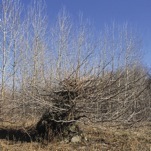-
 Poison ivy does not cause an allergic reaction in animals besides humans.
Poison ivy does not cause an allergic reaction in animals besides humans. -
 Poison ivy is perennial, the plant flowers in April through June, when the leaves are about half open. The fruits culminate in the fall and the leaves drop once the temperature descend below freezing.
Poison ivy is perennial, the plant flowers in April through June, when the leaves are about half open. The fruits culminate in the fall and the leaves drop once the temperature descend below freezing. -
 Poison ivy in North America dates back to the 1600s
Poison ivy in North America dates back to the 1600s -
 Urushiol can stay potent for up to 5 years.
Urushiol can stay potent for up to 5 years. -
 Poison ivy rashes are not contagious
Poison ivy rashes are not contagious -
 Poison ivy is closely related to mangos. Mango peel can hold urushiol and can give people an allergic reaction.
Poison ivy is closely related to mangos. Mango peel can hold urushiol and can give people an allergic reaction. -
 The robust roots in poison ivy helps prevent erosion
The robust roots in poison ivy helps prevent erosion -
 Poison ivy size and urushiol volume and CO2 in the air have a direct correlation. Watch a video on this correlation here.
Poison ivy size and urushiol volume and CO2 in the air have a direct correlation. Watch a video on this correlation here. -
 Poison ivy pollen is a main of honey in the midwestern and southern states of the U.S.
Poison ivy pollen is a main of honey in the midwestern and southern states of the U.S. -
 Urushiol was used as a dye by the Native Americans
Urushiol was used as a dye by the Native Americans -
 Early europeans intentionally planted poison ivy along embankments intending to have the roots used as support.
Early europeans intentionally planted poison ivy along embankments intending to have the roots used as support.


Spring Summer
Fall Winter





